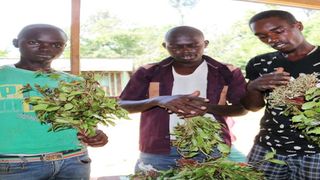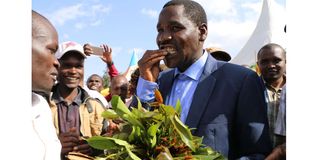
Residents of Thunu village in Meru county prepare khat for sale.
| Charles Wanyoro | Nation Media GroupMeru
Premium
How miraa went from 'drug' to political raw nerve, holy grail of Meru
In 1972, Ntonyiri MP Joseph Muturia devised a plan to have Kenya’s first President, Mzee Jomo Kenyatta, recognise miraa as a cash crop.
This was after a long fight stretching back to the colonial era that saw many paint the plant as a hard drug.
Mr Muturia, as he recently recalled to the Nation, managed to influence Mzee Kenyatta to plant the crop at his Ichaweri home in Gatundu.
Five years later, in 1977, during question time in Parliament, an MP from West Pokot demanded to know why the police were harassing miraa transporters.
Then Attorney-General Charles Njonjo replied that according to the law, khat was a drug, just like bhang.
The following day a local newspaper carried Mr Njonjo’s pronouncement.
Armed with the newspaper, Mr Muturia says, he went to the President’s office and accused the AG of claiming the President had planted bhang in his home.
In tow were then powerful Lands minister Jackson Angaine and Mzee Jomo’s son Peter Muigai.
“The trick worked. The President called Njonjo in our presence and asked him in Kikuyu: ‘Njonjo, why are you saying I have bhang in my home?’ he asked three times. To which Njonjo replied that the law said so and not himself. He was ordered to remove the legislation from the Statutes with immediate effect,” Mr Muturia recently recalled.

Mr Joseph Muturia (right) presents a 1977/78 report to former Agriculture minister Jeremiah Nyagah.
Fast forward to 2020.
Garissa Township MP Aden Duale touched a raw nerve when he recently told the National Assembly that miraa (khat) was allocated Sh1 billion in April 2016 for political reasons.
In a sharp reaction to Mr Duale’s remarks, Imenti South MP Kathuri Murungi said Meru leaders had given the Garissa lawmaker seven days to apologise or face the wrath of Njuri Ncheke elders and residents of the region.
According to Mr Murungi, the Garissa MP had not only insulted the people of Meru for insinuating miraa was a drug, but had also misrepresented President Uhuru Kenyatta’s position that Miraa is a bona fide crop and the economic mainstay of Meru region.
Political importance
Mr Muturia’s political trick on Jomo Kenyatta, the bitter condemnation of Mr Duale and the Sh1 billion kitty for the revival of khat farming ahead of the 2017 elections point to the primacy of the crop in the economy and politics in Meru.
The incidents also show the extent which Meru leaders must go to protect the crop.
Nyambene Miraa Traders Association (Nyamita) chairman Kimathi Munjuri said in order to secure more votes in the 2017 elections, Tharaka Nithi and Embu, where a variety of the crop called muguka is grown, were roped into the plan.
The fund was, however, scaled down to Sh906 million, with Sh27 million being set aside for administrative expenses and Sh879 million to be shared among the three counties — Sh670 million for Meru, Sh167 million (Embu) and Sh42 million (Tharaka-Nithi).
Mr Muturia traces the roots of miraa politics to the 1940s, when the crop was banned in a decade-long campaign.
The former lawmaker says in April 1947 and later in 1951, the colonial government imposed a law prohibiting trade and transportation of miraa and restricted its consumption to Meru and Embu.
“The mzungu was doing lucrative coffee business, but when the Arabs started buying miraa in tonnes, the colonialists discovered there was more of the stimulant at the port of Mombasa for export than coffee.
“They banned it and imposed a hefty fine of Sh2,000 on whoever would be found trading, consuming or transporting it. Since that was a lot of money at the time, nobody dared break the law. It went into the black market until after independence,” says the octogenarian who has farmed and traded in the crop for more than 40 years.
In an article titled ‘Khat in Colonial Kenya: A History of Prohibition and Control”, David Anderson and Neil Carrier noted that when the law was imposed, the stimulant was smuggled across the country with weekly cash remittances at the Meru post office hitting Sh13,000, a tidy sum of money at the time.
“Supply of khat to regular consumers beyond Meru and Embu — the so-called addicts — immediately proved contentious. Agents were appointed to supply Isiolo, Nyeri, Nairobi and Mombasa towns…but it soon became clear that there were many more ‘addicts’ in other parts of the country. Kitui was typical,” they wrote in the article published in the Journal of African History in 2009.
On September 26, Agriculture Cabinet Secretary Peter Munya and East African Legislative Assembly MP Mpuru Aburi accused a section of Meru MPs led by Senator Mithika Linturi of being used by Deputy President William Ruto to discredit President Kenyatta over the problems facing miraa farmers.

Agriculture CS Peter Munya shares miraa with residents of Naikuriu, Igembe North on June 8, 2017.
Mr Linturi had claimed during a miraa stakeholders’ meeting in Igembe Central that the government was to blame for the closure of the lucrative miraa market in Somalia and threatened to organise demonstrations if the issue was not resolved.
Players in the sector, however, feel that playing politics around miraa only serves to aggravate the problems faced by the farmers.
Considered a mild stimulant, miraa is outlawed in the US, Canada, India, United Kingdom, Netherlands and Tanzania.
It was banned in the UK in June 2014 following claims that criminals were using the miraa trade network for illegal activities, including smuggling, drug trafficking and money laundering.
In Kenya, several counties, including Mombasa, Kilifi, Garissa and Kwale have tried to control its use by imposing legislations that have largely not been enforced.
In Meru, casting miraa in negative light is not taken lightly. It is such an emotive topic that even suggesting farmers should diversify to other crops can cost a leader an elective seat.
Cultural importance
It also has immense cultural significance and is even used for dowry payment.
Over the years, there has been a public outcry after speeding vehicles transporting khat killed tens of people on the Meru-Nairobi road. The police have, however, not been able to tame the Probox vans from Embu and overloaded pick-ups from Meru to Nairobi that drive at dangerous speeds, hooting and with full lights on.
Politicians seeking votes exploit the emotions associated with the stimulant in their campaigns.
According to Mr Munjuri, “Meru simply melts at the mention of the crop.”
He goes on: “The problems have been compounded by the abolishment of the committee that was supposed to steer reforms in the sector. In the four years the committee was in existence, politics was limited but when it was abolished in May this year, the ship was left without the captain. Now anybody can jump in and claim to be steering it. Expect things to get worse as we draw closer to the 2022 elections.”
In Igembe, where most of the crop is produced, people rely on foodstuffs from other parts of the county. Truckloads of potatoes, tomatoes and other fresh produce are transported to Maua each day, with traders from Imenti doing brisk business with miraa growers.
Bleeding money daily
When exports were banned in the UK, records indicated that around 2,560 tonnes of khat worth $23.4 million (Sh2.3 billion) was exported to the UK between 2011 and 2012.
And after exports to Somalia were suspended, Nyamita estimates farmers and traders have been losing Sh17 million daily, which works out to more than Sh2.5 billion over the past five months alone.
The Meru County Integrated Development Plan 2018-2022 estimates that miraa injects Sh7 billion into the county’s economy annually, with projections that the figure could rise to Sh9.5 billion by 2022, which is now untenable following the ban on exports to Somalia.
The crop is grown by more than 150,000 farmers on more than 11,000 hectares.
Mr Titus Mwenda, a farmer and businessman in Maua town, said after the suspension of exports to Somalia, restaurants, wholesalers and fresh produce traders recorded low sales since the residents’ purchasing power had been curtailed.
“For a long time now we have been treated to political competition among leaders. The Sh1 billion allocated to revive the miraa sub-sector has not had any impact on the ground and we want leaders to be more responsive to farmers’ woes,” Mr Mwenda said.
During political meetings, leaders order a ‘kilo’ of khat, which is placed at the high table. There is normally a photo session, when they are captured pulling twigs from the bunch and pretending to be partaking of the stimulant.
In 2016, while facing Jubilee for the second time in the 2017 General Election, ODM leader Raila Odinga promised to talk to his “friend” John Pombe Magufuli and have Tanzania lift its ban on miraa, forcing Mr Kenyatta to reluctantly assent to the bill acknowledging miraa as a scheduled crop, Mr Munjuri said.
On September 26, when Mr Munya handed over a cheque of Sh122 million to Mwenge Miraa Sacco, it was claimed he was using the money to marshal support for his 2022 gubernatorial bid.
However, the CS maintained he was assisting the farmers access money to uplift the sector.
Nyamita went to court claiming due process had not been followed in picking the sacco to disburse. The association obtained an order, but it was ignored.
And on September 30, during a meeting with sector players at the county headquarters, Governor Kiraitu Murungi said the worst enemy in the development of the crop was “lies, political mischief and propaganda fuelled by people with selfish interests”.





